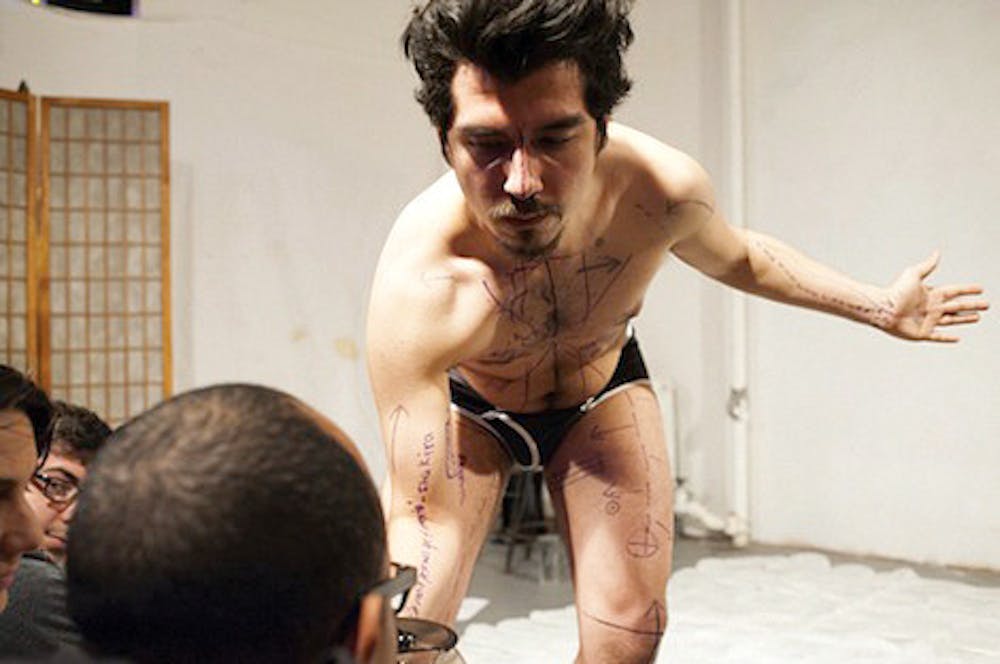Benjamin Lundberg, a performance artist whose work explores issues of transnational identity, is the newest resident artist at AS220, a local nonprofit community arts center based in downtown Providence.
Lundberg previously served as a member of AS220’s rotational Artist in Residence program last September, said Sheyla Rivera, AS220’s director of programs. While artists in residence can stay at AS220 for a period ranging from two weeks to one month, resident artists hold more permanent positions within the community, she said.
The Artist in Residence program dates back to AS220’s move to its current location at Empire Street in downtown Providence. Historically, AS220 has welcomed artists from all over the world, including from countries such as Sri Lanka, South Korea, Germany and Cuba.
Rivera first met Lundberg at an artists’ collective event in Boston.
“I saw his work, and it really (had an impact on) me,” she said. “I thought we should definitely connect, so we did.” Soon after, Rivera invited Lundberg to visit Providence and participate in the AIR program.
The piece that Lundberg worked on during his time in the artist residency was a triptych, or three-part, performance art piece revolving around themes of transnational identities and politics of the body. “The first two parts of it I had been working on for a little over a year,” Lundberg said.
The piece begins with a reenactment of his naturalization ceremony and “then segues into a fully interactive piece where the audience collaborates in giving me a fake elective cosmetic surgery to make me more Colombian,” he said. The piece ends with a resurrection of new possibilities, in which he makes arepas — traditional Colombian flatbread — while speaking and singing in a celebration of his identity.
“My work … specifically draws on a lot of personal narratives,” Lundberg said, noting that he was adopted from Colombia.
“My experience at the residency … allowed me to do a lot more than I was even planning on doing,” he added. “Being in a community with a lot of other artists is fantastic. You get daily interaction with folks who are also making (art).”
Lundberg took advantage of being in Providence to audit a performance studies seminar at Brown, TAPS 2200N: “Liveness: Performance and Neoanimism in Late Capitalism.” He also had the opportunities to show pieces in Rhode Island’s 13th Annual Latin American Art Expo and curate a performance at Aurora, a venue in downtown Providence. Lundberg invited not only artists from the downtown arts community but also master’s and doctoral students at Brown, he said.
“A goal of mine is to contribute to the idea that performance can be deemed as research,” he said. For example, the centerpiece of his work at AS220 focused on observing and archiving the audience’s opinions of Colombia and how they were rendered on a body.
“I also re-inscribe the markings that people put on my body from performance to performance,” Lundberg said. “In that way, my body, as opposed to a research article, becomes an archive for a lot of knowledge that is based on an investigation of stereotypes, or people’s fascination with bodies: Latin American bodies, Colombian bodies.”
But “there is a tension” between artists and scholars at Brown and those in the greater downtown area, Lundberg said. “Even geographically, it’s a pretty stark manifestation of the divide,” he added. “The geography of the hill really lends itself to the idea that academia is an ivory tower.”
“As somebody who is coming in as an outsider, I felt like it was easier for me to navigate that relationship,” he added. “It really mirrors my relationship to my work and my identity, since I feel outside of the U.S. and outside of Colombia.”
Lundberg said he identifies with both the academic and creative attitudes toward art that he found in Providence. “I drew inspiration from two different worlds and methodologies,” he said. After his initial departure from Providence, he continued to commute back and forth before finally moving in the first week of January.
Residency is very flexible, and artists are offered all of AS220’s facilities and tools during that time, Rivera said. Though residents are not required to finish projects, it is mandatory to participate in at least one public showcase of work, she added.
Lundberg will reside in the communal living space on the third floor of AS220, where 11 other artists live and work. “First and foremost, the communal living aspect of the residency is what is most valuable,” Lundberg said.
AS220 programs “over five hundred performances a year, so there’s something going on every single night,” he added. “To be in an environment” where people “are creating all the time” and “performance is happening all around you every day, is really fantastic.”
The AIR Program has been an “interesting way that AS220 connects with a broader network of artists,” Rivera said. She added that AS220 tries to focus on supporting artists who do not necessarily have the time or space to do work, or whose work is culturally specific.
Young artists are increasingly expected to immediately produce sellable work, Rivera said. “Residencies allow for the process of the artist to take priority. I think it helps artists figure out what route they want to take.”





